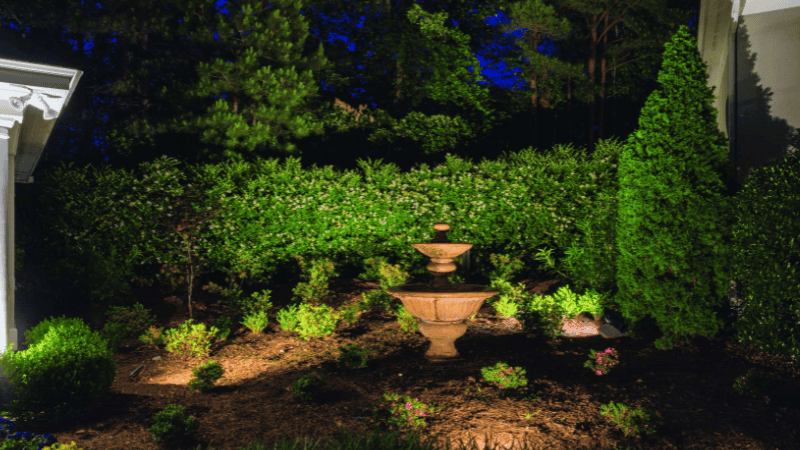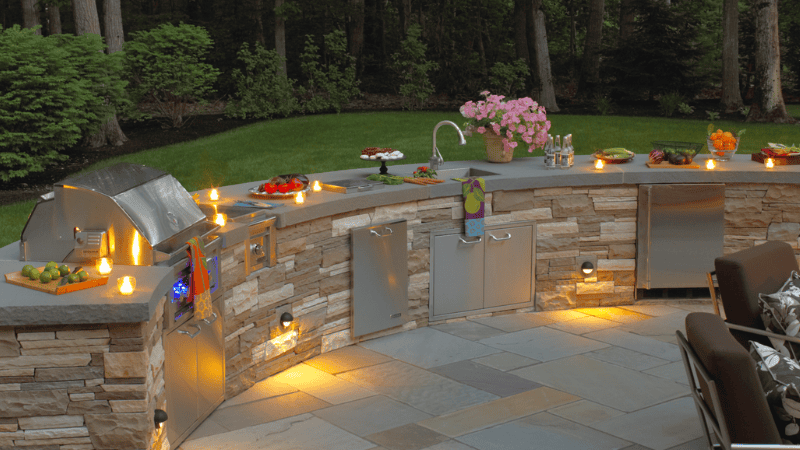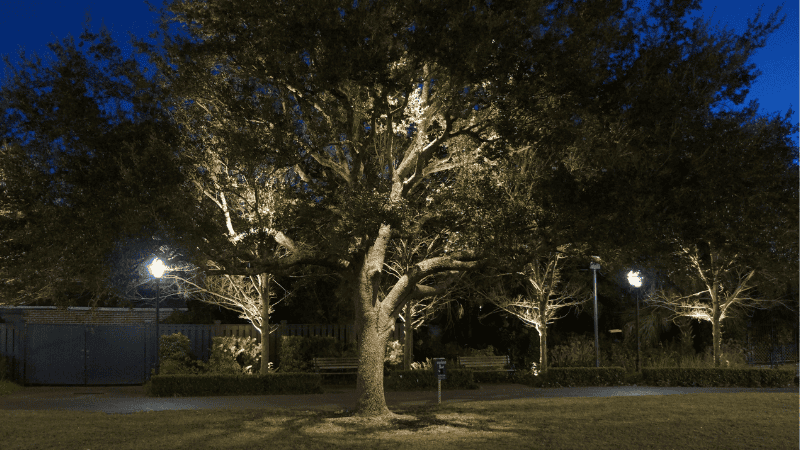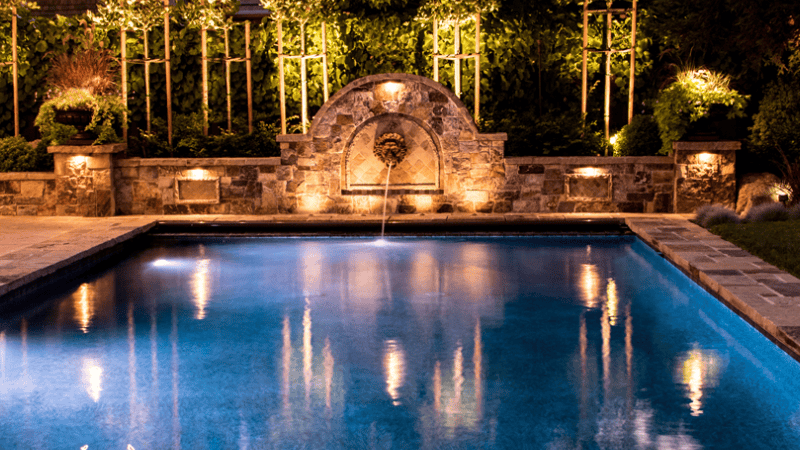When the sun goes down and your yard changes, it’s hard not to stay out and enjoy the atmosphere. But without proper lighting, you’ll never see your outdoor space’s full potential. There are many ways to do this, but uplighting and downlighting are two particularly effective techniques.
Think of an artist with a brush; that’s what uplighting and downlighting can do for your lawn. They bring out the best in architectural features, make trees and flowers glow at night, cast fascinating shadows that add depth — basically everything you need for some backyard drama.

This blog post focuses on uplighting and downlighting — what they’re good for, where they work best — but we should also touch on choosing fixtures. How do you know which ones will create the most stunning effect?
And once you’ve got them, where should lights be placed around your property? Finally: how can these two strategies be balanced to enhance each other rather than clash?
Uplighting Vs. Downlighting: Overview
Rather than getting into the nitty-gritty of outdoor lighting, we should first establish what distinguishes uplighting from downlighting.
Uplighting
Uplighting consists of setting light fixtures at ground level and directing their beams upward. This method is particularly effective for bringing out the best in architectural elements such as columns, walls, or trees. Casting light from below creates a strong dramatic effect that enhances textures and produces intriguing shadows.
Advantages of Uplighting:
- Emphasizes architectural details making them more visible
- Adds depth and theatricality by casting interesting dark areas
- Illuminates trees and shrubs from bottom to top thus underscoring their natural beauty

Disadvantages of Uplighting:
- It can cause light pollution when not correctly focused
- It might require multiple fixtures to cover larger areas adequately
- Potential for glare if wrongly positioned
Ask For Free Quote
Let us Respond Promptly for your Needs :)
Downlighting
Downlighting is achieved by placing light fixtures above the area you want to illuminate so that they shine downwards. This technique is perfect for lighting up pathways, seating spaces, or garden features. It casts a narrower and more concentrated beam, allowing one to highlight specific spots with greater accuracy.
Advantages of Downlighting:
- Provides directed illumination along paths leading to sitting areas besides highlighting such places themselves as well as various objects within gardens
- Ensures safety and visibility in busy sections where people walk frequently
- Reduces both light pollution & glare if used correctly

Disadvantages of Downlighting:
- Not well scattered it may produce hard shadows or “hot spots”.
- May block walkways or seating areas if not placed properly.
- Doesn’t work as effectively in illuminating architectural elements or tall structures.
Ask For Free Quote
Let us Respond Promptly for your Needs :)
Areas In Your Yard That Need Illumination
Before you begin planning for outdoor lighting, you should know which parts of your yard need strategic illumination. These are some common areas:
- Outdoor walls
- Architectural columns or pillars
- Trees and shrubbery
- Water features (pools, fountains, etc.)
- Seating areas (benches, patio furniture)
- Pathways and walkways
- Fences or gates
- Garden beds or focal points
By doing this, you can position your light fixtures appropriately so that every region attains the right brightness level while bringing out its unique characteristics.
Which Lighting Is Best for Your Yard?
Now that you know the difference between uplighting and downlighting, which one should you put in your yard? There isn’t a single correct answer. Most often, the best solution is to use both methods together to suit the particular outdoor space and desired mood.

1. Placing Fixtures in the Right Positions
Where you position your lighting fixtures will determine their effectiveness. For uplighting, place ground-level lights to shine on architectural details, trees, or walls. Make sure the fixtures are placed where they cast interesting shadows and create depth.
For downlighting, mount fixtures on structures or trees; let them shine onto pathways, seating areas, or garden features below. Be careful of any obstructions and adjust angles if necessary to avoid casting unwanted shadows or causing glare.
2. Balancing Uplighting & Downlighting
The real magic happens when you find that perfect balance between uplights and downlights. Using these two techniques together will help round out your space visually. Use uplights to accent architectural details and create dramatic shadow while using downlights to light functional areas for safety & visibility.
Think about what kind of ambiance you want overall. If it’s warm and cozy, maybe more emphasis should be put on uplighting, which creates this inviting glow around everything it touches.
On the other hand, if it’s more about functionality or being well, perhaps downlighting should take priority, as this ensures things can be seen, thus making them safe, too.
Ask For Free Quote
Let us Respond Promptly for your Needs :)
Installation and Maintenance Considerations
When installing outdoor lights, consider their weather resistance, energy efficiency, and ease of maintenance before settling on one type over another if options exist within the same budget range, etcetera. Choose fixtures designed for outside use with strong weatherproof housings made of durable materials.
Also, consider where future maintenance needs might arise—bulb replacements, etcetera. Placing fixtures in easy reach for such eventualities could save you time and effort later on.
Choosing LED for your outdoor yard lighting
Outside light-emitting diode (LED) technology has been a game-changer in the lighting field. It is much better than traditional methods because it offers many benefits over usual incandescent or halogen bulbs, making them perfect for use.
- Energy Efficiency: These lights use very little power, meaning they consume less electricity than their counterparts. Thus, they enable one to save on bills and simultaneously conserve the environment around their home.
- Long Lifespan: Normally, LED lamps can last up to several thousand hours, significantly longer than any other type available today! This implies that fewer replacements are needed, eventually saving effort and cash.

- Versatility: These illuminants can be used with different color temperatures, so depending on your preference, you can create warm, welcoming atmospheres or even cool, crisp brightness.
- Durability: They are known for being strong against shocks, vibrations, and extreme temperatures, making them suitable for outdoor purposes.
By choosing LEDs to illuminate outside spaces, you will achieve higher energy efficiency, an extended life span, and more colors while promoting sustainable development goals for all.
Conclusion
Yard lighting is a form of art. These light methods, such as uplighting and downlighting, are like paintbrushes that allow you to realize your imaginative perception. Knowing the subtleties of these lighting techniques and getting the right blend can transform any backyard into an enchanting heaven that caters to every sense.
Remember that successful outdoor lighting design involves determining what needs to be illuminated, where fixtures should be placed, and how they should interact with uplights and downlights for extra depth or drama.
During darkness, let welcome light shine through every crack so that its beauty may be seen by you and those around you. Also always consider such factors as shadows produced when objects are lit from above or below them.
Elevate Your Outdoor Ambiance with RC Lighting Solutions!
Upgrade your outdoor lighting experience with RC Lighting’s innovative solutions. From uplighting to downlighting, discover the perfect balance to illuminate your yard with style and sophistication.
Contact us Now! Illuminate your outdoor space with RC Lighting today!



